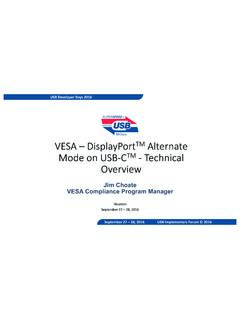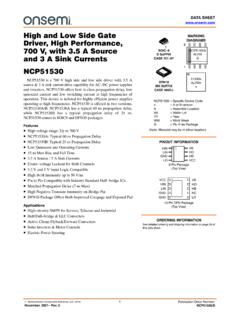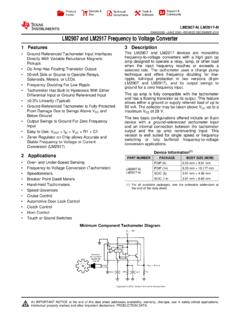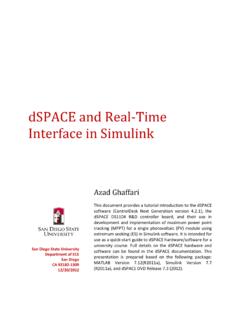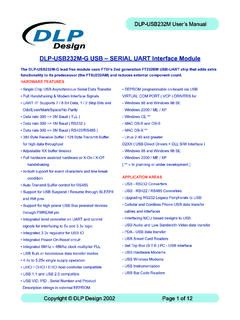Transcription of NCP1342 - Quasi-Resonant Flyback Controller, High Frequency
1 DATA SHEET. Quasi-Resonant Flyback 9 8. Controller, High Frequency 1 1. SOIC 9 NB SOIC 8 NB. NCP1342 . D SUFFIX D SUFFIX. CASE 751BP CASE 751. The NCP1342 is a highly integrated quasi resonant Flyback controller suitable for designing high performance off line power MARKING DIAGRAMS. converters. With an integrated active X2 capacitor discharge feature, 9 8. the NCP1342 can enable no load power consumption below 30 mW. The NCP1342 features a proprietary valley lockout circuitry, 1342abcde 1342abcde ensuring stable valley switching. This system works down to the 6th ALYWf ALYWf valley and transitions to Frequency foldback mode to reduce switching G G. losses. As the load decreases further, the NCP1342 enters quiet skip 1 1. mode to manage the power delivery while minimizing acoustic noise. To ensure light load performance with high Frequency designs, the 1342abcde = Specific Device Code NCP1342 incorporates Rapid Frequency Foldback with Minimum A = Assembly Location Peak Current Modulation to reduce the switching Frequency quickly.
2 L = Wafer Lot To help ensure converter ruggedness, the NCP1342 implements Y = Year W = Work Week several key protective features such as internal brownout detection, a f = Additional Options Code non dissipative Over Power Protection (OPP) for constant maximum G = Pb Free Package output power regardless of input voltage, a latched overvoltage and NTC ready overtemperature protection through a dedicated pin, and line removal detection to safely discharge the X2 capacitors when the PIN CONNECTIONS. ac line is removed. 1. Fault HV. Features FMAX. FB VCC. Integrated High Voltage Startup Circuit with Brownout Detection ZCD/OPP DRV. Integrated X2 Capacitor Discharge Capability CS GND. Wide VCC Range from 9 V to 28 V. 1. 28 V VCC Overvoltage Protection Fault HV. Abnormal Overcurrent Fault Protection for Winding Short Circuit or FB VCC.
3 Saturation Detection ZCD/OPP DRV. Internal Temperature Shutdown CS GND. Valley Switching Operation with Valley Lockout for Noise Free (Top Views). Operation Frequency Foldback with 25 kHz Minimum Frequency Clamp for ORDERING INFORMATION. Increased Efficiency at Light Loads See detailed ordering and shipping information on page 4 of Rapid Frequency Foldback for Fast Reduction of Switching this data sheet. Frequency at Light Loads Skip Mode with Quiet Skip Technology for Highest Performance During Light Loads Minimized Current Consumption for No Load Power Below 30 mW. Frequency Jittering for Reduced EMI Signature Latching or Auto Recovery Timer Based Overload Protection Adjustable Overpower Protection (OPP). Adjustable Maximum Frequency Clamp Fault Pin for Severe Fault Conditions, NTC Compatible for OTP. 4 ms Soft Start Timer Semiconductor Components Industries, LLC, 2017 1 Publication Order Number: August, 2022 Rev.
4 25 NCP1342 /D. NCP1342 . TYPICAL APPLICATION SCHEMATIC. Vout + +. NCP1342 . Fault HV. +. FB VCC. L EMI ZCD/OPP DRV. Filter N CS GND. t +. Figure 1. NCP1342 8 Pin Typical Application Circuit Vout + +. NCP1342 . Fault HV. FMAX. +. FB VCC. L EMI ZCD/OPP DRV. Filter N CS GND. t +. Figure 2. NCP1342 9 Pin Typical Application Circuit 2. NCP1342 . Table 1. PART NUMBER DECODE NCP1342 ABCDEF. NCP1342 A B C D E F*. OTP/Overload Jitter Frequency /Amplitude Quiet Skip CS Min CS Min Shift Additional A AR/AR A kHz/75 mV A 800 Hz A 200 mV A 400 mV . B Latch/AR B kHz/92 mV B kHz B 150 mV B 350 mV A. C AR/Latch C kHz/55 mV C kHz C 100 mV C 300 mV C. D Latch/Latch D kHz/61 mV D Disabled D 250 mV D 250 mV D. E AR/None E kHz/75 mV E Disabled E. F Latch/None F kHz/92 mV F. Device G kHz/55 mV G. H kHz/61 mV H. J kHz/75 mV. K kHz/92 mV. L kHz/55 mV. M kHz/61 mV.
5 N Disabled *Not present in all parts. See Table 2 for details. Table 2. ADDITIONAL PART OPTIONS. F Description Default Configuration A X2 Discharge Disabled, VBO(stop) = 84 V, VBO(start) = 94 V. D X2 Discharge Disabled, VBO(stop) = 84 V, VBO(start) = 94 V, Resettable Overload Timer E X2 Discharge Disabled, Brownout Disabled F X2 Discharge Disabled, VCC(off) Triggers Autorecovery Timer (trestart). G X2 Discharge Disabled H VBO(stop) = 84 V, VBO(start) = 94 V. 3. NCP1342 . Table 3. ORDERING INFORMATION. Part Number Device Marking Package Shipping NCP1342 AMDCCDR2G 1342 AMDCC SOIC 8 NB (Pb Free). NCP1342 ANDAAD1R2G 1342 ANDAA. NCP1342 DADBDD1R2G 1342 DADBD. NCP1342 AMDCDAD1R2G 1342 AMDCDA. NCP1342 AMAACD1R2G 1342 AMAAC. NCP1342 ANACED1R2G 1342 ANACE. NCP1342 ANDBDD1R2G 1342 ANDBD. NCP1342 BKDCDAD1R2G 1342 BKDCDA. NCP1342 BMDCDAD1R2G 1342 BMDCDA.
6 NCP1342 BMDCDD1R2G 1342 BMDCD. NCP1342 BMDCDDD1R2G 1342 BMDCDD. SOIC 9 NB (Pb Free) 2500 / Tape & Reel NCP1342 AMDCDD1R2G 1342 AMDCD. NCP1342 ANACCED1R2G 1342 ANACCE. NCP1342 ENACEFD1R2G 1342 ENACEF. NCP1342 AMDADGD1R2G 1342 AMDADG. NCP1342 AMDCDHD1R2G 1342 AMDCDH. NCP1342 ENDCEAD1R2G 1342 ENDCEA. NCP1342 DADBDGD1R2G 1342 DADBDG. NCP1342 ADDCDAD1R2G 1342 ADDCDA. NCP1342 ANDCDAD1R2G 1342 ANDCDA. (In Development). 4. NCP1342 . FUNCTIONAL BLOCK DIAGRAM. TSD BO. VDD X2/BO Detect HV. Abnormal OCP X2 +. IFMAX OVLD Fault VCC(OVP) VCC. FMAX FMAX QR_FMAX OVP Management Management Control OTP. VCC. FB Valley/FF. Control Fault Off Time Dead Time ZCD/OPP. Control Control OPP. Control VCC. QR_FMAX t tout VFB(open) OPP Clamp Quiet Skip FB Control R FB S Q DRV. Jitter Ramp K FB R. GND. FB . MPCM On Time FB Control Control Fault V DD. V DD.
7 IOTP. ICS. OVP OVP/OTP. ILIM1 Fault CS t LEB1 t OVLD OVLD OTP Detect Detect RFault(clamp). OPP. ILIM2 V Fault(clamp). t LEB2 Count 4 Abnormal OCP. Detect 8 Pin 9 Pin Figure 3. NCP1342 Block Diagram Table 4. PIN FUNCTIONAL DESCRIPTION. 8 Pin 9 Pin Pin Name Function 1 1 Fault The controller enters fault mode if the voltage on this pin is pulled above or below the fault thresholds. A precise pull up current source allows direct interface with an NTC thermistor. 2 FMAX A resistor to ground sets the value for the maximum switching Frequency clamp. If this pin is pulled above 4 V, the maximum Frequency clamp is disabled. 2 3 FB Feedback input for the QR Flyback controller. Allows direct connection to an optocoupler. 3 4 ZCD/OPP A resistor divider from the auxiliary winding to this pin provides input to the demagnetization de- tection comparator and sets the OPP compensation level.
8 4 5 CS Input to the cycle by cycle current limit comparator. 5 6 GND Ground reference. 6 7 DRV This is the drive pin of the circuit. The DRV high current capability ( /+ A) makes it suit- able to effectively drive high gate charge power MOSFETs. 7 8 VCC This pin is the positive supply of the IC. The circuit starts to operate when VCC exceeds 17 V and turns off when VCC goes below 9 V (typical values). After start up, the operating range is 9 V up to 28 V. 9 N/C Removed for creepage distance. 8 10 HV This pin is the input for the high voltage startup and brownout detection circuits. It also contains the line removal detection circuit to safely discharge the X2 capacitors when the line is removed. 5. NCP1342 . Table 5. MAXIMUM RATINGS. Rating Symbol Value Unit High Voltage Startup Circuit Input Voltage VHV(MAX) to 700 V. High Voltage Startup Circuit Input Current IHV(MAX) 20 mA.
9 Supply Input Voltage VCC(MAX) to 30 V. Supply Input Current ICC(MAX) 30 mA. Supply Input Voltage Slew Rate dVCC/dt 1 V/ms Fault Input Voltage VFault(MAX) to VCC + V V. Fault Input Current IFault(MAX) 10 mA. Zero Current Detection and OPP Input Voltage VZCD(MAX) to VCC + V V. Zero Current Detection and OPP Input Current IZCD(MAX) 2/+5 mA. Maximum Input Voltage (Other Pins) VMAX to V. Maximum Input Current (Other Pins) IMAX 10 mA. Driver Maximum Voltage (Note 1) VDRV to VDRV(high) V. Driver Maximum Current IDRV(SRC) 500 mA. IDRV(SNK) 800. Operating Junction Temperature TJ 40 to 125 C. Maximum Junction Temperature TJ(MAX) 150 C. Storage Temperature Range TSTG 60 to 150 C. Power Dissipation (TA = 25 C, 1 oz. Cu, 42 mm2 Copper Clad Printed Circuit) PD(MAX) mW. DR2G Suffix, SOIC 8 450. D1R2G Suffix, SOIC 9 330. Thermal Resistance (TA = 25 C, 1 oz.)
10 Cu, 42 mm2 Copper Clad Printed Circuit) RqJA C/W. DR2G Suffix, SOIC 8 225. D1R2G Suffix, SOIC 9 300. ESD Capability Human Body Model per JEDEC Standard JESD22 A114F (All pins except HV) 2000 V. Human Body Model per JEDEC Standard JESD22 A114F (HV Pin) 800 V. Charge Device Model per JEDEC Standard JESD22 C101F 1000 V. Latch Up Protection per JEDEC Standard JESD78E 100 mA. Stresses exceeding those listed in the Maximum Ratings table may damage the device. If any of these limits are exceeded, device functionality should not be assumed, damage may occur and reliability may be affected. 1. Maximum driver voltage is limited by the driver clamp voltage, VDRV(high), when VCC exceeds the driver clamp voltage. Otherwise, the maximum driver voltage is VCC. 6. NCP1342 . Table 6. ELECTRICAL CHARACTERISTICS: (VCC = 12 V, VHV = 120 V, VFault = open, VFB = V, VCS = 0 V, VZCD = 0 V, VFMAX.



